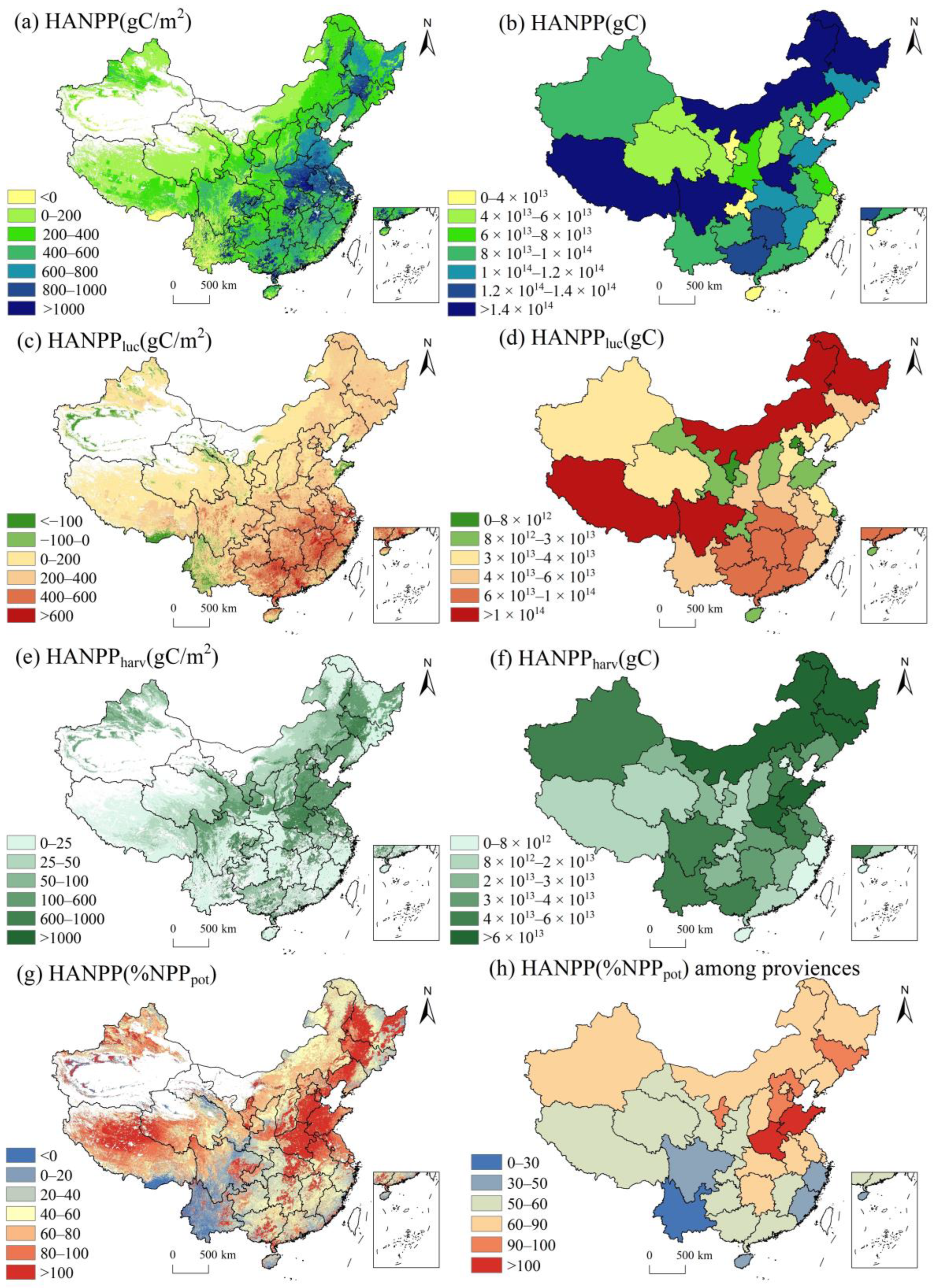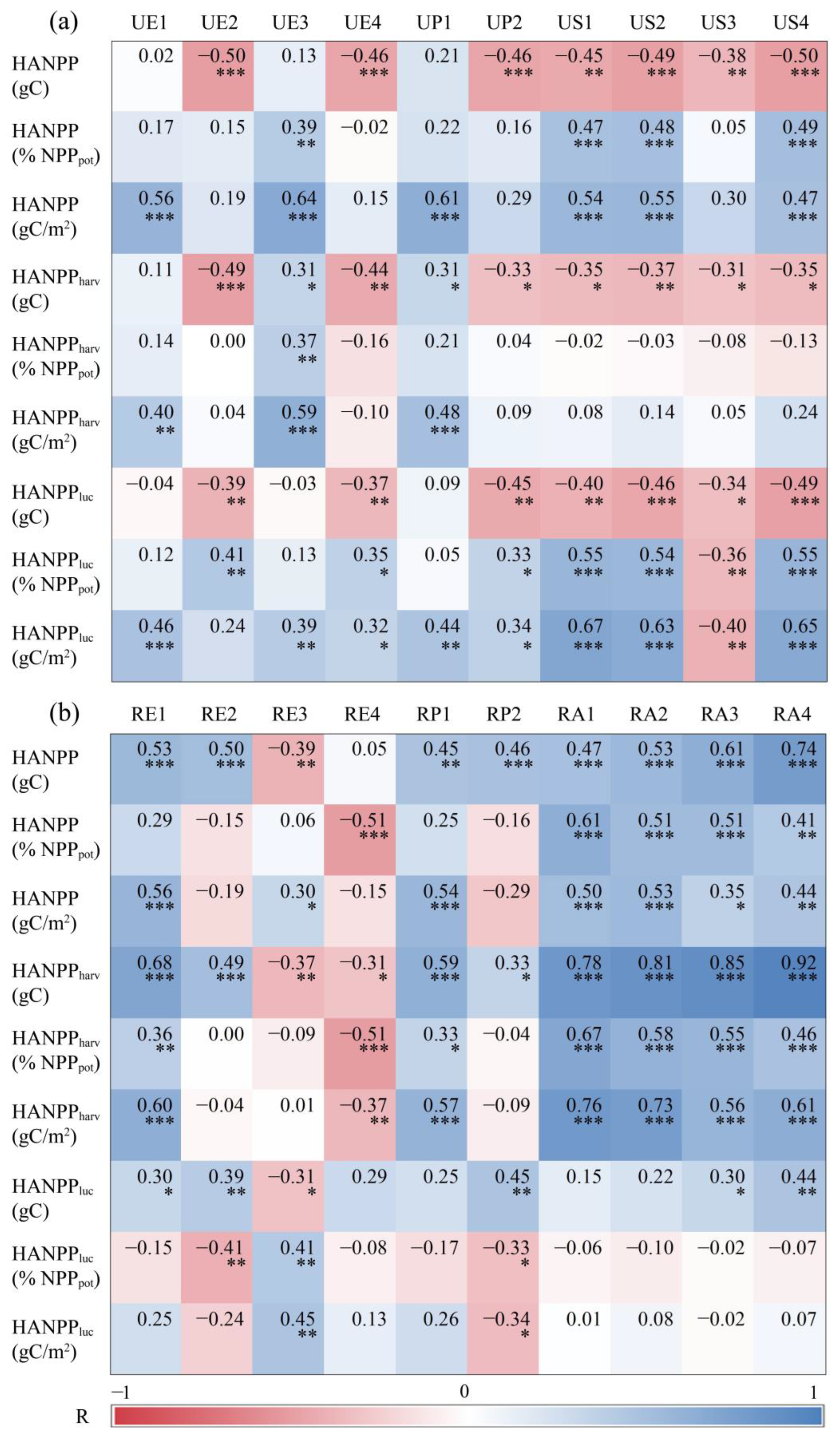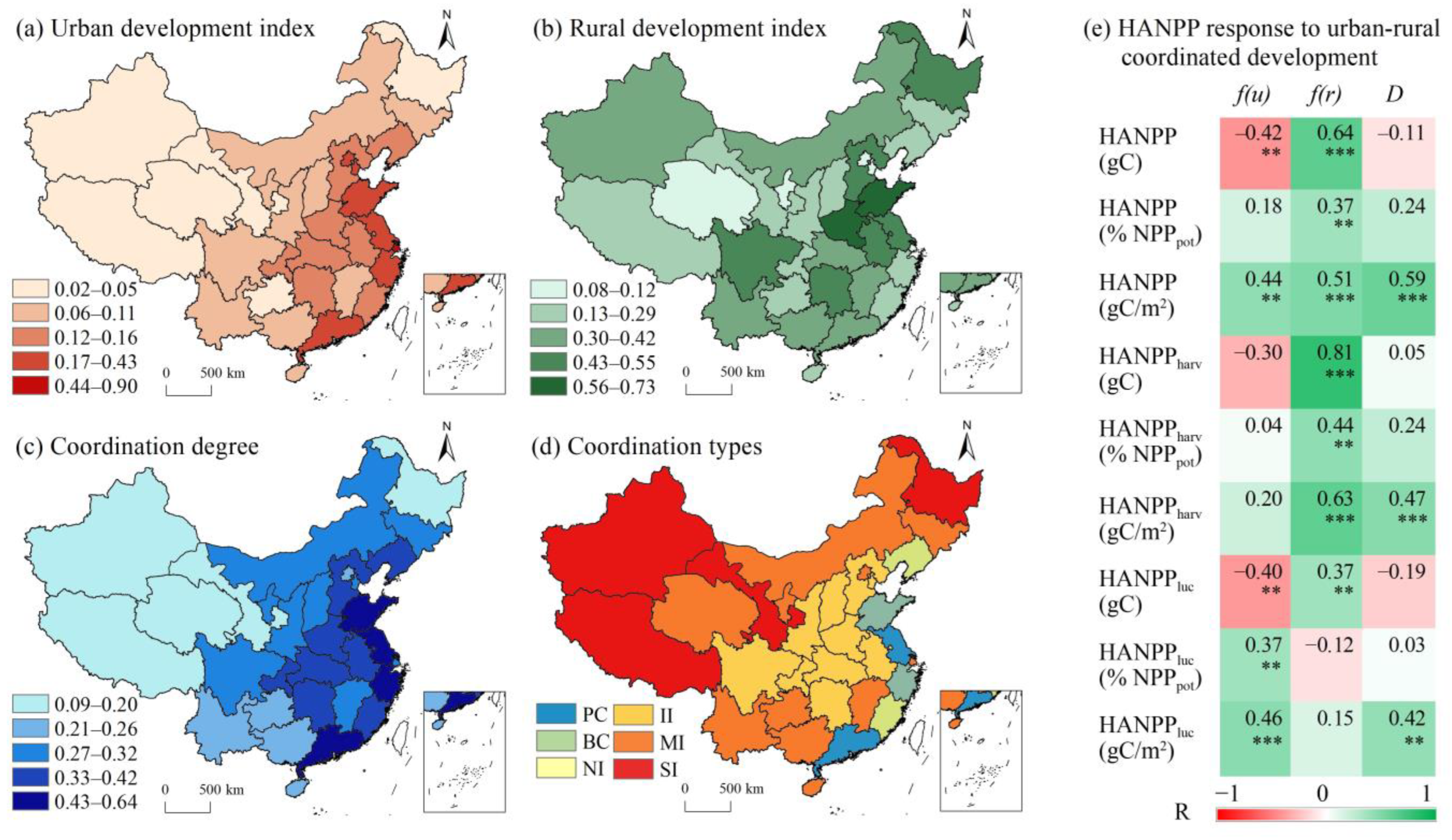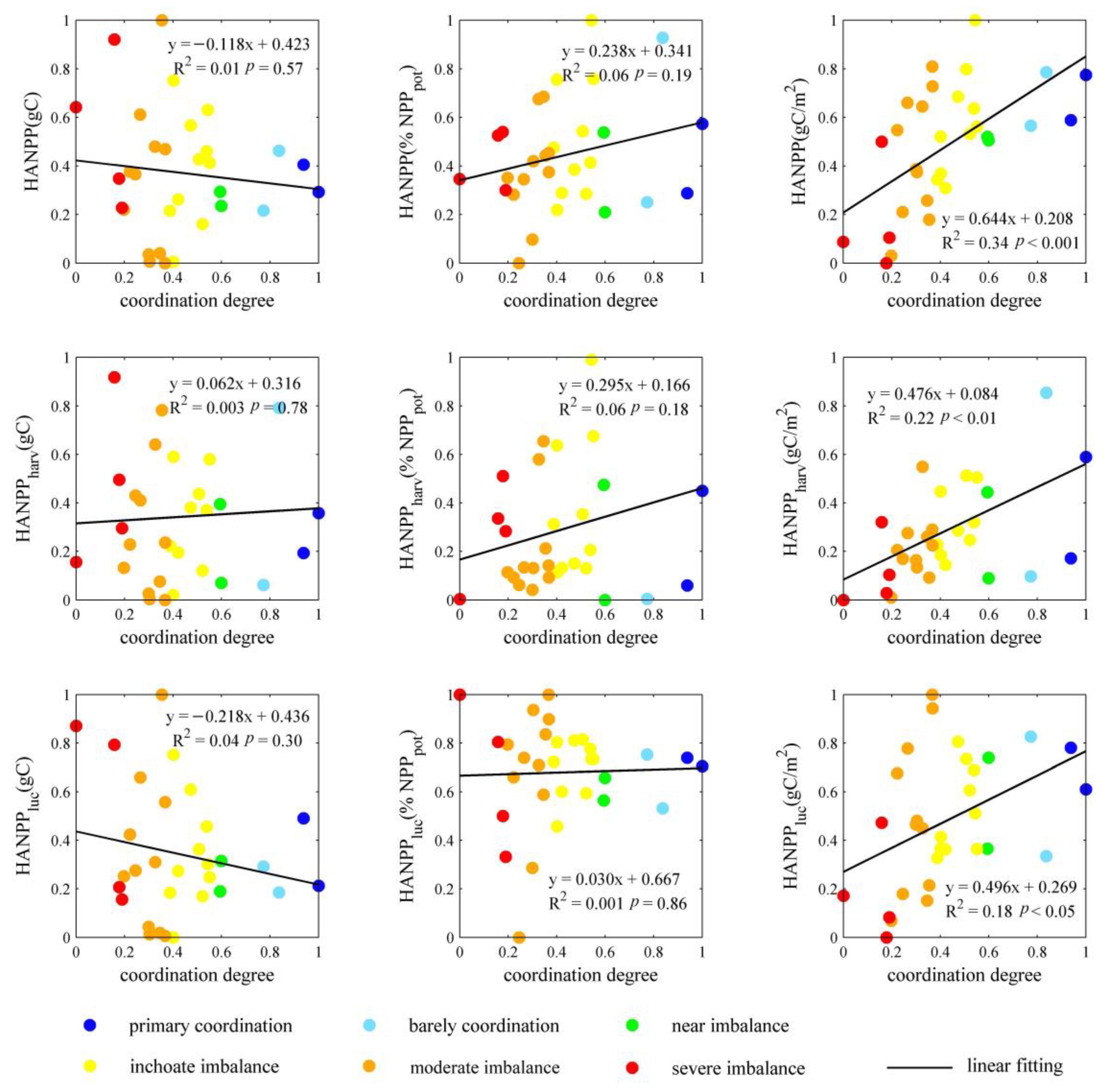China’s Urban and Rural Development Significantly Affects the Pattern of Human Appropriation of Net Primary Production
Abstract
:1. Introduction
2. Materials and Methods
2.1. Data Sources
2.2. Estimation Model of HANPP
2.3. Quantification of Urban and Rural Development
2.4. Statistical Methods
3. Results
3.1. Spatial Distribution of HANPP in China
3.2. Contributions of HANPP Components
3.3. Regional Differentiations in HANPP
4. Discussion
4.1. Credibility of HANPP
4.2. Relationships between HANPP and China’s Urban and Rural Development
4.3. HANPP Responses to Coordinated Regional Urban–Rural Development
4.4. Dominant Driving Factors of Each HANPP Index
5. Conclusions
Supplementary Materials
Author Contributions
Funding
Data Availability Statement
Acknowledgments
Conflicts of Interest
References
- Fan, Y.P.; Fang, C.L. Eco-city and man-land relationship. Acta Ecol. Sin. 2022, 42, 4313–4323. [Google Scholar]
- O’Neill, D.W.; Tyedmers, P.H.; Beazley, K.F. Human appropriation of net primary production (HANPP) in Nova Scotia, Canada. Reg. Environ. Chang. 2007, 7, 1–14. [Google Scholar] [CrossRef]
- Schwarzlmueller, E. Human appropriation of aboveground net primary production in Spain, 1955–2003: An empirical analysis of the industrialization of land use. Ecol. Econ. 2009, 69, 282–291. [Google Scholar] [CrossRef]
- Piao, S.L.; Fang, J.Y.; Zhou, L.M.; Zhu, B.; Tan, K.; Tao, S. Changes in vegetation net primary productivity from 1982 to 1999 in China. Glob. Biogeochem. Cycles 2005, 19, 1605–1622. [Google Scholar] [CrossRef]
- Chen, A.F.; Li, R.Y.; Wang, H.L.; He, B. Quantitative assessment of human appropriation of aboveground net primary production in China. Ecol. Model. 2015, 312, 54–60. [Google Scholar] [CrossRef]
- Epstein, T.S.; Jezeph, D. Development-There is another way: A rural-urban partnership development paradigm. World Dev. 2001, 29, 1443–1454. [Google Scholar] [CrossRef]
- Jiang, C.J.; Li, J.T.; Liu, J.L. Does urbanization affect the gap between urban and rural areas? Evidence from China. Socio-Econ. Plan. Sci. 2022, 82, 101271. [Google Scholar] [CrossRef]
- Gao, Y.Y.; Zheng, J.H.; Bu, M.L. Rural-urban income gap and agricultural growth in China: An empirical study on the provincial panel data, 1978–2010. China Agric. Econ. Rev. 2014, 6, 92–107. [Google Scholar] [CrossRef]
- Yu, B.B. Ecological effects of new-type urbanization in China. Renew. Sustain. Energy Rev. 2021, 135, 110239. [Google Scholar] [CrossRef]
- Du, X.J.; Huang, Z.H. Ecological and environmental effects of land use change in rapid urbanization: The case of Hangzhou, China. Ecol. Indic. 2017, 81, 243–251. [Google Scholar] [CrossRef]
- Haase, D.; Toetzer, T. Urban-rural linkages-analysing, modelling, and understanding drivers, pressures, and impacts of land use changes along the rural-to-urban gradient. Environ. Plan. B-Urban 2012, 39, 194–197. [Google Scholar] [CrossRef]
- Ren, Y.F.; Fang, C.L.; Li, G.D.; Sun, S.A.; Bao, C.; Liu, R.W. Progress in local and tele-coupling relationship between urbanization and eco-environment. Acta Geogr. Sin. 2020, 75, 589–606. [Google Scholar]
- Chen, Y.; Luo, P.; Chang, T. Urbanization and the urban–rural income gap in China: A continuous wavelet coherency analysis. Sustainability 2020, 12, 8261. [Google Scholar] [CrossRef]
- Pan, Y.; Yu, C.Q.; Zhang, X.Z.; Chen, B.X.; Wu, J.X.; Tu, Y.L.; Miao, Y.J.; Luo, L.M. A modified framework for the regional assessment of climate and human impacts on net primary productivity. Ecol. Indic. 2016, 60, 184–191. [Google Scholar] [CrossRef]
- Teixido-Figueras, J.; Steinberger, J.K.; Krausmann, F.; Haberl, H.; Wiedmann, T.; Peters, G.P.; Duro, J.A.; Kastner, T. International inequality of environmental pressures: Decomposition and comparative analysis. Ecol. Indic. 2016, 62, 163–173. [Google Scholar] [CrossRef]
- Haberl, H.; Erb, K.H.; Krausmann, F.; Gaube, V.; Bondeau, A.; Plutzar, C.; Gingrich, S.; Lucht, W.; Fischer-Kowalski, M. Quantifying and mapping the human appropriation of net primary production in earth’ terrestrial ecosystems. Proc. Natl. Acad. Sci. USA 2007, 104, 12942–12945. [Google Scholar] [CrossRef] [PubMed]
- Kastner, T.; Matej, S.; Forrest, M.; Gingrich, S.; Haberl, H.; Hickler, T.; Krausmann, F.; Lasslop, G.; Niedertscheider, M.; Plutzar, C.; et al. Land use intensification increasingly drives the spatiotemporal patterns of the global human appropriation of net primary production in the last century. Glob. Chang. Biol. 2021, 28, 307–322. [Google Scholar] [CrossRef]
- Krausmann, F.; Erb, K.H.; Gingrich, S.; Haberl, H.; Bondeau, A.; Gaube, V.; Lauk, C.; Plutzar, C.; Searchinger, T.D. Global human appropriation of net primary production doubled in the 20th century. Proc. Natl. Acad. Sci. USA 2013, 110, 10324–10329. [Google Scholar] [CrossRef]
- Niedertscheider, M.; Gingrich, S.; Erb, K.H. Changes in land use in South Africa between 1961 and 2006: An integrated socio-ecological analysis based on the human appropriation of net primary production framework. Reg. Environ. Chang. 2012, 12, 715–727. [Google Scholar] [CrossRef]
- Plutzar, C.; Kroisleitner, C.; Haberl, H.; Fetzel, T.; Bulgheroni, C.; Beringer, T.; Hostert, P.; Kastner, T.; Kuemmerle, T.; Lauk, C.; et al. Changes in the spatial patterns of human appropriation of net primary production (HANPP) in Europe 1990–2006. Reg. Environ. Chang. 2016, 16, 1225–1238. [Google Scholar] [CrossRef]
- Mahbub, R.B.; Ahmed, N.; Rahman, S.; Hossain, M.M.; Sujauddin, M. Human appropriation of net primary production in Bangladesh, 1700–2100. Land Use Policy 2019, 87, 104067. [Google Scholar] [CrossRef]
- Huang, X.; Yang, Y.; Chen, C.; Zhao, H.; Yao, B.; Ma, Z.; Ma, L.; Zhou, H. Quantifying and mapping human appropriation of net primary productivity in Qinghai grasslands in China. Agriculture 2022, 12, 483. [Google Scholar] [CrossRef]
- Andersen, C.B.; Donovan, R.K.; Quinn, J.E. Human appropriation of net primary production (HANPP) in an agriculturally-dominated watershed, southeastern USA. Land 2015, 4, 513–540. [Google Scholar] [CrossRef]
- Zhang, Y.J.; Pan, Y.; Zhang, X.Z.; Wu, J.X.; Yu, C.Q.; Li, M.; Wu, J.S. Patterns and dynamics of the human appropriation of net primary production and its components in Tibet. J. Environ. Manag. 2018, 210, 280–289. [Google Scholar] [CrossRef] [PubMed]
- Roux, N.; Kastner, T.; Erb, K.H.; Haberl, H. Does agricultural trade reduce pressure on land ecosystems? Decomposing drivers of the embodied human appropriation of net primary production. Ecol. Econ. 2021, 181, 106915. [Google Scholar] [CrossRef]
- Imhoff, M.L.; Bounoua, L.; Ricketts, T.; Loucks, C.; Harriss, R.; Lawrence, W.T. Global patterns in human consumption of net primary production. Nature 2004, 429, 870–873. [Google Scholar] [CrossRef]
- Niedertscheider, M.; Kuemmerle, T.; Müller, D.; Erb, K.H. Exploring the effects of drastic institutional and socio-economic changes on land system dynamics in Germany between 1883 and 2007. Glob. Environ. Chang. 2014, 28, 98–108. [Google Scholar] [CrossRef]
- Krausmann, F. Land use and industrial modernization: An empirical analysis of human influence on the functioning of ecosystems in Austria 1830–1995. Land Use Policy 2001, 18, 17–26. [Google Scholar] [CrossRef]
- Gingrich, S.; Niedertscheider, M.; Kastner, T.; Haberl, H.; Cosor, G.; Krausmann, F.; Kuemmerle, T.; Müller, D.; Reith-Musel, A.; Jepsen, M.R.; et al. Exploring long-term trends in land use change and aboveground human appropriation of net primary production in nine European countries. Land Use Policy 2015, 47, 426–438. [Google Scholar] [CrossRef]
- Kastner, T. Trajectories in human domination of ecosystems: Human appropriation of net primary production in the Philippines during the 20th century. Ecol. Econ. 2009, 69, 260–269. [Google Scholar] [CrossRef]
- Dorninger, C.; Wehrden, H.V.; Krausmann, F.; Bruckner, M.; Feng, K.S.; Hubacek, K.; Erb, K.H.; Abson, D.J. The effect of industrialization and globalization on domestic land-use: A global resource footprint perspective. Glob. Environ. Chang. 2021, 69, 102311. [Google Scholar] [CrossRef]
- Haberl, H.; Steinberger, J.K.; Plutzar, C.; Erb, K.H.; Gaube, V.; Gingrich, S.; Krausmann, F. Natural and socioeconomic determinants of the embodied human appropriation of net primary production and its relation to other resource use indicators. Ecol. Indic. 2012, 23, 222–231. [Google Scholar] [CrossRef]
- Marull, J.; Tello, E.; Bagaria, G.; Font, X.; Cattaneo, C.; Pino, J. Exploring the links between social metabolism and biodiversity distribution across landscape gradients: A regional-scale contribution to the land-sharing versus land-sparing debate. Sci. Total Environ. 2018, 619–620, 1272–1285. [Google Scholar] [CrossRef]
- Haberl, H.; Plutzar, C.; Erb, K.H.; Gaube, V.; Pollheimer, M.; Schulz, N.B. Human appropriation of net primary production as determinant of avifauna diversity in Austria. Agric. Ecosyst. Environ. 2005, 110, 119–131. [Google Scholar] [CrossRef]
- Zhou, C.; Elshkaki, A.; Graedel, T. Global human appropriation of net primary production and associated resource decoupling: 2010–2050. Environ. Sci. Technol. 2018, 52, 1208–1215. [Google Scholar] [CrossRef] [PubMed]
- Krausmann, F.; Haberl, H.; Erb, K.H.; Wiesinger, M.; Gaube, V.; Gingrich, S. What determines geographical patterns of the global human appropriation of net primary production? J. Land Use Sci. 2009, 4, 15–33. [Google Scholar] [CrossRef]
- Das, B.; Chakrabarty, D. Lagrange’s interpolation formula: Representation of numerical data by a polynomial curve. Int. J. Math. Trends Technol. 2016, 34, 64–72. [Google Scholar] [CrossRef]
- Wright, D.H. Human impacts on energy flow through natural ecosystems, and implications for species endangerment. Ambio 1990, 19, 189–194. [Google Scholar]
- Rojstaczer, S.; Sterling, S.M.; Moore, N.J. Human appropriation of photosynthesis products. Science 2001, 294, 2549–2552. [Google Scholar] [CrossRef]
- Haberl, H.; Erb, K.H.; Krausmann, F. Human appropriation of net primary production: Patterns, trends, and planetary boundaries. Annu. Rev. Environ. Resour. 2014, 39, 363–391. [Google Scholar] [CrossRef]
- Fetzel, T.; Gradwohl, M.; Erb, K.H. Conversion, intensification, and abandonment: A human appropriation of net primary production approach to analyze historic land-use dynamics in New Zealand 1860–2005. Ecol. Econ. 2014, 97, 201–208. [Google Scholar] [CrossRef]
- Yuan, Q.Z.; Wu, S.H.; Dai, E.F.; Zhao, D.S.; Ren, P.; Zhang, X.R. NPP vulnerability of China’s potential vegetation to climate change in the past 50 years. Acta Geogr. Sin. 2016, 71, 797–806. [Google Scholar]
- Du, J.S.; Yu, D.Y. Impacts of climate change and human activities on net primary productivity of grassland in agro-pastoral transitional zone in northern China. J. Beijing Norm. Univ. 2018, 54, 365–372. [Google Scholar]
- Erb, K.H.; Fetzel, T.; Plutzar, C.; Kastner, T.; Lauk, C.; Mayer, A.; Niedertscheider, M.; Körner, C.; Haberl, H. Biomass turnover time in terrestrial ecosystems halved by land use. Nat. Geosci. 2016, 9, 674–678. [Google Scholar] [CrossRef]
- Zhang, F.Y.; Pu, L.J.; Huang, Q. Quantitative assessment of the human appropriation of net primary production (HANPP) in the coastal areas of Jiangsu, China. Sustainability 2015, 7, 15857–15870. [Google Scholar] [CrossRef]
- Schwarzlmüller, E. Human appropriation of net primary production (HANPP) in Spain, 1955–2003: A socio-ecological analysis. In Social Ecology Working Paper 99; Faculty for Interdisciplinary Studies, Klagenfurt University: Vienna, Austria, 2008. [Google Scholar]
- Wang, F.X.; Mao, A.H.; Li, H.L.; Jia, M.L. Quality measurement and regional difference of urbanization in Shandong Province based on the entropy method. Sci. Geogr. Sin. 2013, 33, 1323–1329. [Google Scholar]
- Wang, W. The evaluation of coordinated development level between urban and rural and its spatial-temporal pattern in Yangtze River economic zone. Econ. Geogr. 2017, 37, 60–66. [Google Scholar]
- Wang, Y.; Sun, P.J.; Li, C.G.; Liu, H.; Zhou, J. Spatial-temporal evolution features of urban and rural harmonious in northeast China since 2003. Econ. Geogr. 2018, 38, 59–66. [Google Scholar]
- Liu, Y. Grassland monitoring report in China in 2015. Chin. Animat. Anime 2016, 6, 18–35. [Google Scholar]
- Huang, Q.; Zhang, F.; Zhang, Q.; Ou, H.; Jin, Y. Quantitative assessment of the impact of human activities on terrestrial net primary productivity in the Yangtze River Delta. Sustainability 2020, 12, 1697. [Google Scholar] [CrossRef]






| Objects | Perspective | Indexes | Symbols * | Weights |
|---|---|---|---|---|
| Urban | Economy | Added value of the secondary and tertiary industries (108 CNY) | UE1 | 0.065 |
| Proportion of added value of the secondary and tertiary industries (%) | UE2 | 0.019 | ||
| Added value of transportation, warehousing, and postal services (108 CNY) | UE3 | 0.051 | ||
| Per capita consumption expenditure of urban residents (CNY) | UE4 | 0.084 | ||
| Population | Urban population (104 people) | UP1 | 0.045 | |
| Proportion of urban population (%) | UP2 | 0.020 | ||
| Space | Nighttime light intensity (nW/cm2/sr) | US1 | 0.194 | |
| Proportion of built-up area (%) | US2 | 0.147 | ||
| Proportion of urban green spaces (%) | US3 | 0.243 | ||
| Proportion of urban road area (%) | US4 | 0.134 | ||
| Rural | Economy | Added value of the primary industry (108 CNY) | RE1 | 0.103 |
| Proportion of added value of the primary industry (%) | RE2 | 0.058 | ||
| Per capita consumption expenditure of rural residents (CNY) | RE3 | 0.073 | ||
| Engel coefficient of rural residents (%) | RE4 | 0.134 | ||
| Population | Rural population (104 people) | RP1 | 0.118 | |
| Proportion of rural population (%) | RP2 | 0.037 | ||
| Agricultural technology | Total power of agricultural machinery (104 kW) | RA1 | 0.129 | |
| Application amount of agricultural fertilizer (104 tons) | RA2 | 0.112 | ||
| Effective irrigated area (103 hectare) | RA3 | 0.125 | ||
| Total sown area of crops (103 hectare) | RA4 | 0.111 |
| D Value | Implications | D Value | Implications | D Value | Implications |
|---|---|---|---|---|---|
| 0 < D ≤ 0.2 | Severe imbalance | 0.4 < D ≤ 0.5 | Near imbalance | 0.7 < D ≤ 0.8 | Intermediate coordination |
| 0.2 < D ≤ 0.3 | Moderate imbalance | 0.5 < D ≤ 0.6 | Barely coordination | 0.8 < D ≤ 0.9 | Well coordination |
| 0.3 < D ≤ 0.4 | Inchoate imbalance | 0.6 < D ≤ 0.7 | Primary coordination | 0.9 < D ≤ 1 | Super coordination |
| Indexes | Regional Differentiation * | ||||||||
|---|---|---|---|---|---|---|---|---|---|
| Zone 1 | Zone 2 | Zone 3 | Zone 4 | ||||||
| t Value | p Value | t Value | p Value | t Value | p Value | t Value | p Value | ||
| HANPP | (gC) | −0.433 | 0.668 | −0.780 | 0.441 | 0.293 | 0.772 | −2.323 | 0.027 * |
| (%NPPpot) | −0.009 | 0.993 | 2.141 | 0.041 * | 3.672 | 0.001 *** | 0.474 | 0.639 | |
| (gC/m2) | 5.933 | 0.001 *** | 4.924 | 0.001 *** | −2.341 | 0.026 * | 2.170 | 0.039 * | |
| HANPPharv | (gC) | 0.191 | 0.850 | 0.258 | 0.798 | 1.667 | 0.109 | −1.649 | 0.110 |
| (%NPPpot) | −0.035 | 0.973 | 1.450 | 0.158 | 3.721 | 0.001 *** | 0.308 | 0.760 | |
| (gC/m2) | 2.647 | 0.013 * | 3.730 | 0.001 *** | 0.786 | 0.441 | 0.942 | 0.354 | |
| HANPPluc | (gC) | −0.531 | 0.616 | −1.335 | 0.192 | −0.654 | 0.518 | −2.167 | 0.039 * |
| (%NPPpot) | 0.066 | 0.984 | 1.939 | 0.062 | 0.525 | 0.604 | 0.498 | 0.623 | |
| (gC/m2) | 8.477 | 0.00 1 *** | 3.314 | 0.002 ** | −5.817 | 0.001 *** | 1.881 | 0.070 | |
| Dependent Variables | Independent Variables | Model with Standardized Coefficients | R | |
|---|---|---|---|---|
| HANPP | (gC) | Urban | = −0.599UE2 + 0.366UP1 | 0.613 |
| Rural | = 1.111RA4 + 0.348RE4 − 0.365RP1 | 0.823 | ||
| Urban–rural | = 0.650RA4 − 0.309US4 | 0.797 | ||
| (%NPPpot) | Urban | = 1.223UE3 − 0.924UE1 | 0.567 | |
| Rural | = 1.007RA1 − 1.044RP1 − 0.384RE2 + 0.599RA2 | 0.849 | ||
| Urban–rural | = 1.007RA1 − 1.045RP1 + 0.384UE2 + 0.599RA2 | 0.849 | ||
| (gC/m2) | Urban | = 0.642UE3 | 0.642 | |
| Rural | = 0.628RE1 − 0.401RP2 | 0.682 | ||
| Urban–rural | = 0.642UE3 | 0.642 | ||
| HANPPharv | (gC) | Urban | = −0.672UE2 + 0.543UE3 | 0.706 |
| Rural | = 0.897RA4 − 0.371RP1 + 0.345RA2 | 0.940 | ||
| Urban–rural | = 0.897RA4 − 0.371RP1 + 0.345RA2 | 0.940 | ||
| (%NPPpot) | Urban | = 1.245UE3 − 0.978UE1 | 0.566 | |
| Rural | = 1.189RA1 − 0.641RP1 | 0.763 | ||
| Urban–rural | = 1.189RA1 − 0.641RP1 | 0.763 | ||
| (gC/m2) | Urban | = 1.210UE3 − 0.688UE1 | 0.665 | |
| Rural | = 0.846RA1 − 0.315RP2 | 0.822 | ||
| Urban–rural | = 0.340RA1 + 0.771US4 − 0.480UE4 + 0.425RA2 | 0.897 | ||
| HANPPluc | (gC) | Urban | = −0.486US4 | 0.486 |
| Rural | = 0.356RP2 + 0.912RA4 − 0.698RA1 | 0.678 | ||
| Urban–rural | = −0.486US4 | 0.486 | ||
| (%NPPpot) | Urban | = 0.412UE2 | 0.412 | |
| Rural | = −0.412RE2 | 0.412 | ||
| Urban–rural | = −0.412RE2 | 0.412 | ||
| (gC/m2) | Urban | = 0.458UE1 | 0.458 | |
| Rural | = 0.513RE3 + 0.357RP1 | 0.568 | ||
| Urban–rural | = 0.458UE1 | 0.458 | ||
Disclaimer/Publisher’s Note: The statements, opinions and data contained in all publications are solely those of the individual author(s) and contributor(s) and not of MDPI and/or the editor(s). MDPI and/or the editor(s) disclaim responsibility for any injury to people or property resulting from any ideas, methods, instructions or products referred to in the content. |
© 2023 by the authors. Licensee MDPI, Basel, Switzerland. This article is an open access article distributed under the terms and conditions of the Creative Commons Attribution (CC BY) license (https://creativecommons.org/licenses/by/4.0/).
Share and Cite
Zhang, T.; Peng, J.; Cao, X. China’s Urban and Rural Development Significantly Affects the Pattern of Human Appropriation of Net Primary Production. Land 2023, 12, 1062. https://doi.org/10.3390/land12051062
Zhang T, Peng J, Cao X. China’s Urban and Rural Development Significantly Affects the Pattern of Human Appropriation of Net Primary Production. Land. 2023; 12(5):1062. https://doi.org/10.3390/land12051062
Chicago/Turabian StyleZhang, Tian, Jian Peng, and Xiaoshu Cao. 2023. "China’s Urban and Rural Development Significantly Affects the Pattern of Human Appropriation of Net Primary Production" Land 12, no. 5: 1062. https://doi.org/10.3390/land12051062
APA StyleZhang, T., Peng, J., & Cao, X. (2023). China’s Urban and Rural Development Significantly Affects the Pattern of Human Appropriation of Net Primary Production. Land, 12(5), 1062. https://doi.org/10.3390/land12051062









